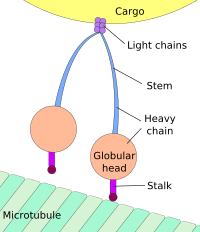
Photo from wikipedia
ABSTRACT Herpes simplex virus (HSV) anterograde transport in neuronal axons is vital, allowing spread from latently infected ganglia to epithelial tissues, where viral progeny are produced in numbers allowing spread… Click to show full abstract
ABSTRACT Herpes simplex virus (HSV) anterograde transport in neuronal axons is vital, allowing spread from latently infected ganglia to epithelial tissues, where viral progeny are produced in numbers allowing spread to other hosts. The HSV membrane proteins gE/gI and US9 initiate the process of anterograde axonal transport, ensuring that virus particles are transported from the cytoplasm into the most proximal segments of axons. These proteins do not appear to be important once HSV is inside axons. We previously described HSV double mutants lacking both gE and US9 that failed to transport virus particles into axons. Here we show that gE− US9− double mutants accumulate large quantities of unenveloped and partially enveloped capsids in neuronal cytoplasm. These defects in envelopment can explain the defects in axonal transport of enveloped virions. In addition, the unenveloped capsids that accumulated were frequently bound to cytoplasmic membranes, apparently immobilized in intermediate stages of envelopment. A gE-null mutant produced enveloped virions, but these accumulated in large numbers in the neuronal cytoplasm rather than reaching cell surfaces as wild-type HSV virions do. Thus, in addition to the defects in envelopment, there was missorting of capsids and enveloped particles in the neuronal cytoplasm, which can explain the reduced anterograde transport of unenveloped capsids and enveloped virions. These mechanisms differ substantially from existing models suggesting that gE/gI and US9 function by tethering HSV particles to kinesin microtubule motors. The defects in assembly of gE− US9− mutant virus particles were novel because they were neuron specific, in keeping with observations that US9 is neuron specific. IMPORTANCE Herpes simplex virus (HSV) and other alphaherpesviruses, such as varicella-zoster virus, depend upon the capacity to navigate in neuronal axons. To do this, virus particles tether themselves to dyneins and kinesins that motor along microtubules from axon tips to neuronal cell bodies (retrograde transport) or from cell bodies to axon tips (anterograde transport). This transit in axons is essential for alphaherpesviruses to establish latency in ganglia and then to reactivate and move back to peripheral tissues for spread to other hosts. Anterograde transport of HSV requires two membrane proteins: gE/gI and US9. Our studies reveal new mechanisms for how gE/gI and US9 initiate anterograde axonal transport. HSV mutants lacking both gE and US9 fail to properly assemble enveloped virus particles in the cytoplasm, which blocks anterograde transport of enveloped particles. In addition, there are defects in the sorting of virus particles such that particles, when formed, do not enter proximal axons.
Journal Title: Journal of Virology
Year Published: 2017
Link to full text (if available)
Share on Social Media: Sign Up to like & get
recommendations!